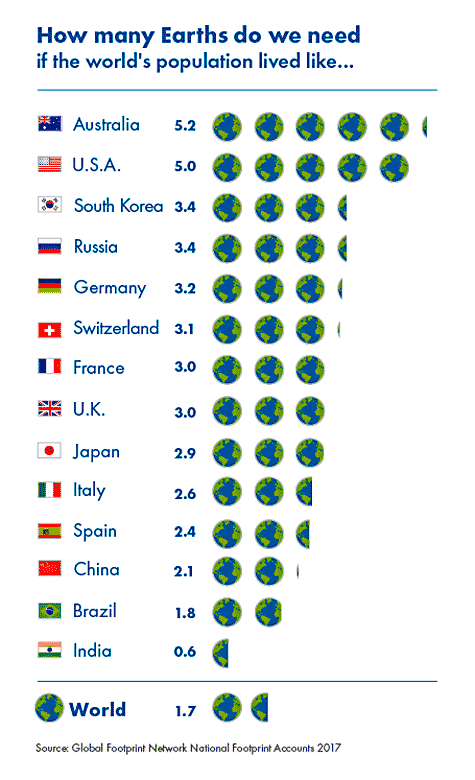Earth Overshoot Day 2017 is August 2, the earliest date since ecological overshoot began in the early 1970s
To ignite change, Global Footprint Network provides #movethedate solutions, metrics, pledges, and new Footprint calculator
(OAKLAND, CA, USA) — JUNE 27, 2017 — On August 2, humanity will have used nature’s budget for the entire year, according to Global Footprint Network, an international research organization that has pioneered the Ecological Footprint resource accounting metric. Carbon sequestration makes up 60 percent of human demand on nature.
Earth Overshoot Day marks the date when humanity’s annual demand on nature exceeds what Earth can regenerate in that year. Earth Overshoot Day has moved from late September in 1997 to August 2 this year, the earliest date since the world first went into overshoot in the early 1970s. In other words, humanity is currently using nature 1.7 times faster than ecosystems can regenerate. This is akin to using 1.7 Earths.
The costs of this global ecological overspending are becoming increasingly evident around the world, in the form of deforestation, drought, fresh-water scarcity, soil erosion, biodiversity loss, and the buildup of carbon dioxide in the atmosphere.
#movethedate towards sustainability
But we can reverse the trend. If we moved Earth Overshoot Day back 4.5 days every year, we would return to using the resources of one planet by 2050.
“Our planet is finite, but human possibilities are not. Living within the means of one planet is technologically possible, financially beneficial, and our only chance for a prosperous future,” said Mathis Wackernagel, CEO of Global Footprint Network and co-creator of the Ecological Footprint. “Ultimately, moving back the date of Earth Overshoot Day on the calendar is the name of the game.”
To mark Earth Overshoot Day 2017, Global Footprint Network highlights opportunities for action that are available today, and estimates their impact on the date of Earth Overshoot Day. For instance, cutting food waste by 50% worldwide could move the date by 11 days; reducing the carbon component of the global Ecological Footprint by 50% would move the date of Overshoot Day by 89 days.
Individual action
To support this transformation, Global Footprint Network together with nearly 30 partners worldwide is encouraging individuals to help #movethedate by making pledges. This includes learning more about sustainability levers and trying out new habits to lower one’s personal Ecological Footprint. Global Footprint Network makes those challenges both informative and playful, so participants can learn while having fun—even entering a photo contest.
As Earth Overshoot Day draws near, Global Footprint Network also will launch a new online Ecological Footprint Calculator to allow users to calculate their personal Earth Overshoot Day. The current calculator (www.footprintcalculator.org) is used by more than 2 million people a year.
Systemic transformation
Furthermore, systemic change is crucial to moving the date of Overshoot Day. This is why Global Footprint Network, which launched its open data platform earlier this year, is helping to spread the word about solutions identified by two organizations: Project Drawdown and McKinsey & Company. Global Footprint Network’s research team built on both organizations‘ work by calculating the number of days by which Earth Overshoot Day would move if the solutions they identified were implemented.
“Humanity’s carbon Footprint alone more than doubled since the early 1970s and remains the fastest growing component of the widening gap between the Ecological Footprint and the planet’s biocapacity,” said Wackernagel. “To achieve the goals of the Paris Climate Accord, humanity would need to exit the fossil fuel economy before 2050. This would go a long way toward addressing humanity’s overshoot problem.”
Encouraging signs
Global Footprint Network’s latest data offer encouraging signs that we are starting to move in the right direction. For instance, the US per capita Ecological Footprint fell nearly 20% from its peak in 2005 to 2013 (the latest year data is available). This significant shift, which includes a post-recession pickup, is associated mostly with decreasing carbon emissions. US per capita GDP grew about 20% over the same period, making the US a compelling case of decoupling (with economic growth and natural resource consumption following opposite trends).
Despite the US national government’s backtracking on climate protection, many US cities, states and large businesses are redoubling their commitments. In addition, China, the country with the largest total Ecological Footprint, is firmly committed to building an Ecological Civilization in its latest five-year plan, with many initiatives to accelerate its carbon peak. Scotland, Costa Rica, and Nicaragua are other examples of countries that are rapidly decarbonizing their energy system.
Earth Overshoot Day / Global Footprint Network.
www.overshootday.org/






